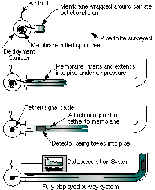

 During recent testing, Pipe
Explorer, a sensor for detecting radiation inside pipes, saved
the U.S. Department of Energy
about $1.5 million in avoided costs. The testing was conducted at
a DOE Formerly Utilized Sites Remedial Action Program site, now
used by General Motors
as an automobile plastics factory. Use of the Pipe Explorer
avoided drain-line excavation and plant impacts, such as the cost
of relocating portions of the active factory. The savings is
nearly three-times the amount invested in Pipe Explorer's
development.
During recent testing, Pipe
Explorer, a sensor for detecting radiation inside pipes, saved
the U.S. Department of Energy
about $1.5 million in avoided costs. The testing was conducted at
a DOE Formerly Utilized Sites Remedial Action Program site, now
used by General Motors
as an automobile plastics factory. Use of the Pipe Explorer
avoided drain-line excavation and plant impacts, such as the cost
of relocating portions of the active factory. The savings is
nearly three-times the amount invested in Pipe Explorer's
development.
Inspecting process piping for radionuclide contamination presents difficulties. Most pipes are checked for contamination using hand-held survey meters like pipe crawlers or push rods, but their use is limited. Often pipes are too small for inspection or contain obstructions, such as elbows, junctions, and valves. Pipe exteriors are not always accessible because they are encased in concrete or are elevated. Pipe crawlers cannot function well in pipes with diameters of four inches or less, especially if the pipe is coated with a slippery material. Push rods are limited in length and moving radiation detectors around pipe elbows is difficult.
To solve these problems, Science and Engineering Associates, Inc., under contract with DOE's Morgantown Energy Technology Center, developed the Pipe Explorer Survey System. It uses air pressure to invert a tubular membrane through which characterization sensors are transported through pipes.
Pipe Explorer design
At the heart of Pipe Explorer is an air-tight membrane, or plastic tube, wound on a spool inside a canister. The end of the membrane protruding from the canister is folded over and attached to a basepipe. The system is placed at the pipe opening. Air pressure inverts the membrane and forces it through the pipe. As the membrane inverts, a tether attached to the free end of the membrane can tow equipment, such as a radiation sensor, video camera, or pipe-locating equipment through the pipe. The membrane goes through the pipe and around elbows, up to 250 hundred feet. It provides a clean conduit for the equipment, preventing cross contamination.
 When the membrane is fully extended,
the equipment can be retrieved through the length of the pipe,
providing detailed radiological measurements as the sensor is
pulled back. As a precautionary measure, two sampling smears are
used to swipe the entire surface of the system's tether. To date,
no contamination has been found inside the membrane.
When the membrane is fully extended,
the equipment can be retrieved through the length of the pipe,
providing detailed radiological measurements as the sensor is
pulled back. As a precautionary measure, two sampling smears are
used to swipe the entire surface of the system's tether. To date,
no contamination has been found inside the membrane.
Currently, Pipe Explorer can be used with a video camera and four types of beta and gamma radiological sensors. Science and Engineering Associates is developing an alpha sensor for use with the system.
Pipe Explorer demonstration
In 1995, the system was demonstrated at a DOE FUSRAP site, an active General Motors automobile plastics factory in Adrian, Michigan. During the 1950's, the site was used by Bridgeport Brass Company as a Special Metals Extrusion Plant. Through a contract with the Atomic Energy Commission (now DOE), the plant produced material for uranium fuel elements for reactors in Hanford, Washington, and the Savannah River Site in South Carolina. Depleted, natural, and up to 2.1 percent enriched uranium-235 were handled in the operation. Over time, waste from the extrusion process mixed with oil from the machinery and flowed into the oil drainage system. The waste contaminated over 1,000 feet of buried drain-lines.
 SEA conducted
two surveys at the site using Pipe Explorer. In April 1995, the
manual (hand crank-controlled) Pipe Explorer system was
demonstrated. A beta detector was transported to a specific
location in the pipe, then the position of the detector and its
output were recorded by the operator. The detector and tether
were successfully deployed and retrieved.
SEA conducted
two surveys at the site using Pipe Explorer. In April 1995, the
manual (hand crank-controlled) Pipe Explorer system was
demonstrated. A beta detector was transported to a specific
location in the pipe, then the position of the detector and its
output were recorded by the operator. The detector and tether
were successfully deployed and retrieved.
The automated system was tested again at the site in May 1995, using a higher sensitivity beta detector. This system uses a motorized reel and deployment distance measurement sensor. Data from the sensors is recorded and displayed on a laptop computer. Surface activity was monitored in real time using this system. The Pipe Explorer was again successful.
Test data were verified using several methods. The first was a visual inspection of the membrane as it was retrieved from the drain-line. Another verification method used a conventional Geiger-Mueller probe. Measurements were found to be more accurate using the Pipe Explorer.
SEA has readied Pipe Explorer for commercialization and is working on a project for its use in the near future. For more information, contact SEA at 6100 Uptown Blvd., NE, Suite 700, Albuquerque, New Mexico 87110; telephone (505) 884-2300.
![]()